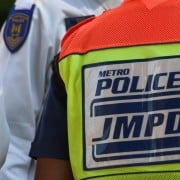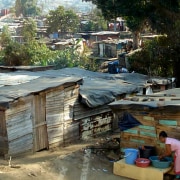|
Getting your Trinity Audio player ready...
|
By Tharin Pillay
Metaphors do more than add colour to poetry — they shape our conception of abstract ideas. They are so embedded in our everyday communications that often we don’t notice them at all. They slide under the radar of our attention. But they are everywhere — I count at least four in this paragraph alone.
When it comes to complex social issues like corruption, where many people have an intuitive, “know-it-when-they-see-it” understanding of the problem but would struggle to give a rigorous definition of what constitutes it, metaphors help fill in the gaps. This can be good, as they help people to understand abstract concepts, but a reliance on metaphors also has some drawbacks: depending on who is using them and to what end, metaphors can obscure more than they reveal.
The ‘fight against corruption’
Take what is perhaps the most common metaphor in South African corruption discourse, that of the “fight against corruption”. References to this fight are everywhere: in government policy documents like the National Anti-Corruption Strategy 2020-2030 (Nacs), which speaks of an “integrated approach to the fight against corruption”; in President Cyril Ramaphosa’s speeches, where he frequently makes claims like “while we have taken decisive steps to end the era of State Capture, we know that the fight against corruption is far from over”; and in the messaging of both media and civil society organisations.
To speak of corruption in this way is to reify it — to imply that it is a physical entity to be fought against. Although this is rhetorically useful insofar as it makes clear that corruption is an enemy to be resisted, reflect on this framing for a while and you’ll find that it raises more questions than it answers.
This is because corruption is, fundamentally, an abstract phenomenon — it can be understood as “the abuse of entrusted power for private gain”. We use the concept to denote a variety of dishonest actions perpetrated by people in power. In this sense, corruption is present in virtually every country in the world, whether democratic or authoritarian (albeit to varying degrees). It is also not particularly well-defined: consider the fine line between bribery and lobbying in America.
Moreover, our sense of which actions constitute corruption has changed over time. In previous centuries, for example, British and French aristocrats saw nothing inherently wrong with appointing individuals to political positions on the basis of personal connection rather than on merit. This is in stark contrast to our situation today, where it is widely accepted that political appointments facilitated the capture of our state.
A losing battle
Given this ubiquity of corruption across time and space, framing corruption as an entity to be fought raises some questions: who exactly are our enemies in this fight? Is the fight at all winnable? If so, what might victory look like? How would we measure it?
The problem here is not that these questions cannot be answered, but rather that politicians usually make no attempt at answering them. Instead, corruption is gestured at only as an abstract bogeyman to be battled against.
One can understand why this is the case: if President Ramaphosa was serious about fighting corruption, his war would need to start by mobilising an army — by directing the state’s capacity and resources towards holding accountable the many members of his party who have been implicated in State Capture, and who have caused the state to lose almost R500-billion through their corruption and mismanagement.
But being more specific with his words may jeopardise his political position (not to mention the stability of the country); so we are left with vague calls to action instead.
Of course, perhaps this is too simplistic. One could argue that the president is playing chess, not checkers; and that behind the scenes, such an army has already been mobilised. This is the recurrent cry of the National Prosecuting Authority (NPA), which has promised that nine “seminal” State Capture cases will be prosecuted over the next six months. Things look somewhat positive on this front, as the NPA has in recent weeks arrested some “big fish”. Whether this will be enough to stymie the state’s slide toward greater dysfunction or to really hold the ruling party to account, only time will tell.
While references to the government’s “fight against corruption” go back at least 15 years, candid reflections from those involved on how that fight has since progressed are harder to come by. It may have once been motivating to hear this rhetoric, but that corruption is still framed as a fight after so many years, with little indication of how we are doing, makes it hard to escape the conclusion that we are caught in a losing battle.
Corruption big and small
Talk of the “fight against corruption” tends to erase all nuance. It conceives of corruption as a hostile force to be resisted, whether it is perpetrated by high-ranking politicians or ordinary citizens just trying to survive.
But there is an important difference between someone who, for example, lives in poverty, needs to support their family and thus pays a small bribe to secure a job, and someone who systematically defrauds the state of billions of rand. This is sometimes framed as the difference between petty corruption and grand corruption.
Of course, corrupt acts exist on a spectrum, can take myriad forms, and there is no bright line that divides grand and petty corruption. So the point here is not that petty corruption is always justified — rather that we should be aware of how it’s often politically advantageous for those in power to conflate different forms of corruption to deflect blame from themselves.
Further, when many members of the public are forced, in the face of dire socioeconomic conditions and broken government institutions, to engage in petty corruption themselves, the language of absolutist war serves only to alienate people. When moralistic language is out of sync with people’s lived experiences, it falls on deaf ears. Especially when corruption by those at the top of the wealth distribution creates dire conditions that lead those at the bottom to engage in corruption themselves.
Framings beyond war
Beyond the framing of war, other common framings include “corruption as a disease” (for example, the Nacs states that “corruption has become endemic in South Africa”) and “corruption as a natural process”. In this latter category, one finds expressions like “South Africa was engrossed in a web of corruption”; “efforts to root out endemic graft… have been mixed”; and “corruption, like a weed, spreads very fast”.
These kinds of metaphors are useful in highlighting that corruption requires a network of actors, all colluding and complicit in one another’s affairs, in order to thrive. They are limited insofar as their focus on the systemic nature of the problem can obscure the culpability of the individuals at the top who perpetrate grand corruption.
It’s worth paying attention to these metaphors — not only because of how they can be deployed to undermine accountability but also because the language we use to frame a problem partially constrains our thinking on how best to solve it.
If corruption is a battle against an enemy, then we need to fight, which primarily looks like prosecution and punishment. If corruption is a virus, we need strategies for diagnosis, treatment, and prevention which look more like educating the public on how to “stay safe”, and reforming national policies to improve the health of our anti-corruption ecosystem. And if corruption is a natural growth, we need to uproot it by removing corrupt officials from power.
We need not commit ourselves to a single framing. Each metaphor adds to our understanding of both what corruption is and how it can be addressed and permits interpretations beyond the ones I’ve offered here.
Taking the fight forward
Corruption is the result of a complex interplay between individuals’ decisions and systemic failures. This can be difficult to keep in mind when we discuss it. But as this is an issue the country will be grappling with for years to come, now is as good a time as any to start thinking creatively about how we conceive of corruption.
In that spirit, let me close by returning to the framing of a fight, to provide some tentative answers to the questions I posed earlier.
Q: Who are our enemies in the fight against corruption?
A: Political officials who abuse their power to pilfer the state’s resources, and private sector actors (especially lawyers, accountants, bankers, and consultants) who enable them to do so, themselves profiting along the way.
Q: Is the fight winnable?
A: If winning means totally eradicating corruption from society, then no. If winning means greatly reducing the extent to which corruption undermines the well-being of our citizens and our democracy, then yes.
Q: What might victory look like?
A: Like guilty parties being held accountable by legal institutions; like government contracts being awarded in a way that is fair, transparent, and cost-effective; and like whistle-blowers receiving the protection they need to disclose information about corrupt activities without fear for their lives.
Q: How would we measure it?
A: By the number of high-profile politicians who are arrested and convicted, by the amounts of money that are recovered by entities like the Special Investigating Unit and the Asset Forfeiture Unit, and, more broadly, by the extent to which we are able to get our economy on track and growing again.
These are crude measures, but they are a start.








